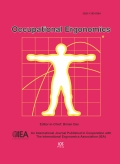Authors: Bhattacharya, Amit | Succop, Paul | Kincl, Laurel | Gordon, Jessica | Sobeih, Tarek
Article Type:
Research Article
Abstract:
The manual material handling tasks in underground low seam mines present a myriad of ergonomic risk factors, which place inordinate demands on the miners' neuromuscular system. The mining industry requires work in restricted postures in mines with low-ceiling heights (low-seam mines). Material handling while in a restricted posture will cause an increase in the potential of loss of stability/balance to increase. Currently, such information does not exist for material handling while in a stooped/kneeling posture. The overall purpose of the study was to quantify postural instability of low seam miners while carrying out mine related tasks. For this study, a
…total of 25 miner subjects were tested. Each subject's postural stability was quantified while performing simulated mining tasks under a low seam ceiling. The quantification of postural stability constituted exposure to individual and combined risk factors of 3 types of surfaces (firm-dry DCOF: 0.90, uneven-dry DCOF: 0.59 and firm slippery surfaces DCOF: 0.22); 2 types of environmental lighting (poor and glare); 2 types of postures (kneeling postures using one knee and two knees); and 4 types of mining tasks (stationary, lifting buckets of bits, lifting cables and scaling). Based on the results, the tasks of lifting of bits, cable lifting, scaling and stationary were ranked least to most stable as they relate to miners' postural balance, respectively. This finding is consistent with ranking of tasks producing the most to least number of observed slip events (during task performance) to be lifting of bits (19.4% slips observed), cable lifting (18.9% slips), scaling (16.3% slips) and stationary tasks (4% slips), respectively. Based on all the experimental conditions that were varied, the one knee posture was more unstable compared to the two-knee posture. A one-knee posture was rated higher in terms of both RPE and PSOS as compared to a two-knee posture, which is consistent with the objective measures of postural stability/balance. While consistency between subjective and objective measure supports the fact that miners were correctly judging the threat of instability associated with the one-knee posture, they were not successful in deploying appropriate and corrective postural responses to minimize slips during task performance with one-knee posture as this posture (as opposed to two-knee posture) produced the largest numbers of slips. This may suggest that a re-evaluation of the methods used to complete tasks be accomplished in order to develop changes in work methods that will minimize slips and/or falls during task performance.
Show more
Keywords: Low seam mining task, postural instability, miners, loss of balance, base of support, perceived sense of slip and fall
DOI: 10.3233/OER-2009-0161
Citation: Occupational Ergonomics,
vol. 8, no. 2-3, pp. 91-114, 2009
Price: EUR 27.50





